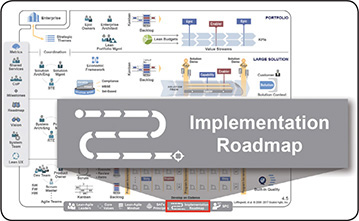

Many leaders pride themselves on setting the high-level direction and staying out of the details. But big picture, hands off leadership isn’t likely to work in a change situation, because the hardest part of change—the paralyzing part—is in the details.
Any successful change requires a translation of ambiguous goals into concrete behaviors. To make a switch, you need to script the critical moves.
—Dan and Chip Heath, Switch: How to Change Things When Change Is Hard
The SAFe Implementation Roadmap consists of an overview graphic and 12-steps that describe a strategy and an ordered set of activities that have proved effective in successfully implementing SAFe.
Achieving the business benefits of Lean-Agile development at scale is not a trivial effort, so SAFe is not a trivial framework. Before realizing SAFe’s rewards, organizations must embrace a Lean-Agile Mindset and understand and apply Lean-Agile principles. They must identify Value Streams and Agile Release Trains (ARTs), implement a Lean-Agile portfolio, build quality in, and establish the mechanisms for continuous value delivery and DevOps. And, of course, the culture must evolve as well.
Based on proven organizational change management strategies, the SAFe Implementation Roadmap graphic and article series describe the steps, or ‘critical moves,’ an enterprise can take to implement SAFe in an orderly, reliable, and successful fashion.
To achieve the desired organizational change, leadership must “script the critical moves,” as described by Dan and Chip Heath [1]. When it comes to identifying those critical moves for adopting SAFe, hundreds of the world’s largest enterprises have already gone down this path, and successful adoption patterns have become clear. A fairly standard pattern is shown in Figure 1.
While no two adoptions are identical, and there is rarely a perfectly sequential step-by-step implementation in any enterprise, we know that businesses getting the best results typically follow a path similar to that shown in the SAFe Implementation Roadmap. It includes the following 12 steps:
Reach the Tipping Point
Train Lean-Agile Change Agents
Train Executives, Managers, and Leaders
Create a Lean-Agile Center of Excellence
Identify Value Streams and ARTs
Create the Implementation Plan
Prepare for ART Launch
Train Teams and Launch the ART
Coach ART Execution
Launch More ARTs and Value Streams
Extend to the Portfolio
Sustain and Improve
This overview serves as a launching pad for you to explore these steps in detail and understand how to apply them to your own implementation. Each step of the SAFe Implementation Roadmap is described in Part 2 of this book.
LEARN MORE
[1] Heath, Chip, and Dan Heath. Switch: How to Change Things When Change Is Hard. Crown Publishing Group, Kindle Edition.
[2] Knaster, Richard, and Dean Leffingwell. SAFe Distilled: Applying the Scaled Agile Framework for Lean Software and Systems Engineering. Addison-Wesley, 2017.